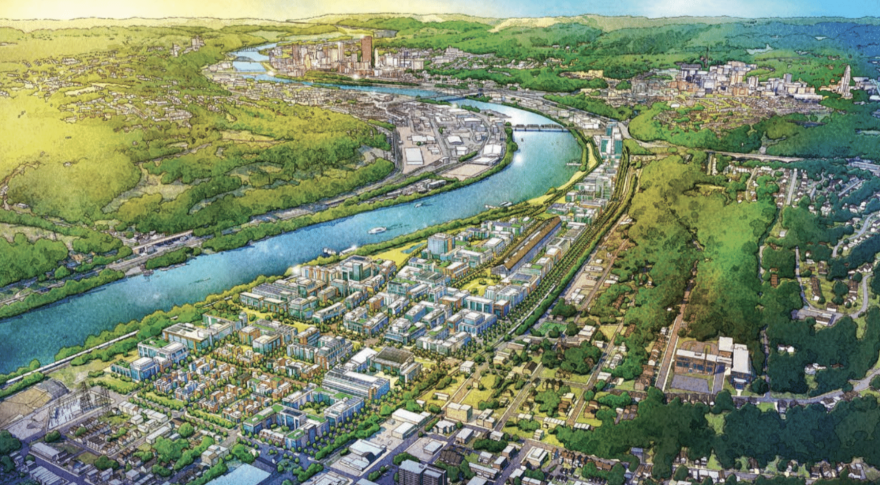At a meeting of Pittsburgh’s Planning Commission on Tuesday, members and staff said they’re worried increases in parking and reductions in building height at Hazelwood Green could threaten the site’s future as a dense, busy neighborhood. However, the development team said that is not their intention.
Zoning administrator Corey Layman told commission members that Department of City Planning staff have been working with the developer on the proposed changes, but worry they present a significant change “from the urban form, density, and environmental goals that have been a part of the mission and intent of Hazelwood Green from the beginning.”
The 178-acre site, which was once occupied by a steel mill, is owned by Almono Limited Partners. The group is made up of three foundations: the Claude Worthington Benedum Foundation, the Richard King Mellon Foundation, and The Heinz Endowments.
The development team is requesting an increase in temporary parking, greater allowances for integral parking and standalone parking garages. In addition, they hope to allow for larger building fronts, eliminate most of the minimum building heights, decrease floor heights, and add some additional uses for the site, from warehousing to assisted-living facilities.
Warehousing, combined with the elimination of most minimum building heights, created concern that the mill site could be dominated by large, single-story buildings.
“We definitely weren’t envisioning that,” said Kristen Hall, an urban planner and consultant for the developer. “We need to just address all the ways that we plan not to enable those things to happen.”
Adding warehousing and other uses such as film production, outdoor entertainment, and assisted living facilities is intended to create more jobs on site, as well as create a vibrant urban neighborhood, Hall said.
“These things aren’t at odds,” she said. “It’s all in the details about how you design them.”
For instance, Hall said removing the requirement that buildings be a minimum of 32 feet would allow construction of two-story townhomes rather than just three-story. That change could mean a cost reduction of more than 30 percent, which could then allow for more affordable sale or rental prices. Adding some single-story spaces can also help create a more intimate, neighborhood feel, said Austin Gelbard, a senior director with developer Tishman Speyer.

“The goal is to … not punish smaller buildings with more height than they need,” he said.
Gelbard assured commissioners “you’re going to get the density you want in this district,” because landowners and developers want the most density they can get; it’s better for their costs. The changes the developers hope to make, he said, are intended “to enable flexibility” to get development rolling on the site.
Increases in the amount and types of parking are also needed to reach a “critical mass” of development around the existing Mill 19 building, Gelbard said.
Jon Kamin, an attorney for the project who works on land use and zoning questions, said the development team understands community and commission concerns that new surface parking lots could make Hazelwood Green into another Waterfront. But Hazelwood Green's developers “have the benefit of hindsight,” he said. “There’s no desire here to turn it [in]to something that’s very suburban.”
Instead, Kamin said the increase in parking is required to make growth at the site work.
“If we had better transit, if we had better accessibility, we would probably have a lot more buildings and a lot more people and a lot more things happening now,” he said.
In response to community feedback that retail along Lytle Street in Hazelwood Green could undermine hopes of revitalizing Hazelwood’s commercial corridor, the developer proposed not to have stores close to Second Avenue. However, commission chair Christine Mondor said she thinks it would be possible to create active uses along the street without competing with the neighborhood.
The Planning Commission is expected to vote on the changes at its meeting on Nov. 23.
Also on Tuesday, the Planning Commission heard a presentation to expand an affordable housing tool to two additional neighborhoods, Bloomfield and Polish Hill.
Inclusionary zoning requires some units in new developments to be affordable to people who earn less than area median income; the rule is already in effect in Lawrenceville. While reminding commissioners about the history of the rule in the city, Andrea Lavin Kossis of the city’s planning department said it was “designed to be applied to multiple neighborhoods.”
During discussion, commissioner Sabina Deitrick said she was “obviously disappointed we still don’t have this citywide,” and urged speed for further expansions.












